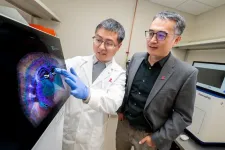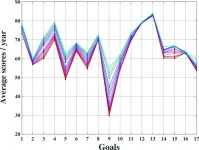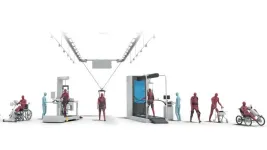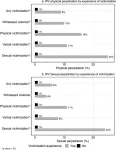(Press-News.org) Spatial transcriptomics is a cutting-edge technique that characterizes gene expression within sections of tissue, such as heart, skin or liver tissue. These snapshots provide insights into how spatial organization affects cellular functions across the spectrum of biology and disease. Up to now, researchers conducting spatial transcriptomics have had to choose between two options based on their needs: genome-wide coverage or single-cell resolution. To solve this tradeoff, scientists at St. Jude Children’s Research Hospital and the University of Wisconsin-Madison have created a computational tool that uses generative artificial intelligence (AI) to enhance the resolution of sequencing-based spatial transcriptomics without sacrificing gene coverage. The algorithm and its first findings were published today in Nature Methods.
“We’ve made the first generative algorithm that can predict spatial gene expression of whole transcriptomics at the single-cell level,” said co-senior and corresponding author Jiyang Yu, PhD, St. Jude Department of Computational Biology interim chair. “The key is to borrow information from single-cell RNA-seq atlas and histology imaging data with this generative modeling approach, giving full transcriptome coverage and single-cell resolution in spatial RNA-sequencing.”
The new computational tool, Spot imager with pseudo single-cell resolution histology (Spotiphy), employs a machine learning algorithm to improve conventional spatial transcriptomics technologies significantly. Those technologies look at predefined “spots” on a grid to capture gene expression. These are essentially the pixels that form the final gene expression image across the entire tissue section. Each spot typically contains multiple, often heterogeneous, cells, making them difficult to classify and analyze into single cells.
Spotiphy uses machine learning that extrapolates cell-type proportions and gene expression data to fill the space between “spots.” The program knows what to fill these gaps with because it was trained on vast spatial transcriptomics databases paired with histological images.
“Imagine a picture of a hand, but the middle is missing,” said co-senior author Junmin Peng, PhD, St. Jude Departments of Structural Biology and Developmental Neurobiology. “The algorithm has acquired general rules from its training so that it can impute the missing part of the picture — like reconstructing where and what the palm should look like, or in reality, the space between imaging spots.”
Spotiphy finds new insights from spatial transcriptomics data
Peng, who studies neurobiology, explained how single-cell spatial transcriptomics provides an opportunity to understand neurodegenerative diseases better, including Alzheimer’s, especially aberrant cells and their gene expression. However, “previous spatial transcriptomics data for Alzheimer’s have not truly resolved single-cell data,” Peng said. “Existing methods result in a low-resolution output, often clustering multiple cells into a single spot. We merged adjacent sections for RNA analysis and imaging one-to-one with Spotiphy, truly reaching a clean single-cell resolution with high gene coverage.
Applied to a mouse model of Alzheimer’s Disease, Spotiphy confirmed the findings of previous studies, validating the tool’s ability to pinpoint cell location and gene expression patterns accurately. This increased confidence in the technique. In addition, the researchers deployed Spotiphy in new experiments, finding that subsets of astrocytes, a common cell type in the central nervous system, are associated with specific brain regions. They also found that disease-associated microglia, a rare type of immune cells, had a greater presence in brains affected by Alzheimer’s, supporting previous findings that microglial dysfunction may be involved in the disease.
“The real power of this algorithm is its ability to distinguish subtle differences within the same cell type that previous technologies could not detect,” Yu said. “For example, identifying sub-populations of astrocytes located in certain areas of the brain.”
Findings were not limited to neurobiology. The scientists also showed that Spotiphy could be used to analyze other tissues, including cancer samples. The tool successfully identified different spatial domains and alterations in tumor-tumor microenvironment interactions.
“We saw the data reflected known breast cancer heterogeneity,” said co-first author Jiyuan Yang, PhD, St. Jude Department of Computational Biology. “We also invested significant efforts to generating the matched datasets for mouse brains, which we believe will be a valuable resource for the spatial omics community.”
“We’ve made a tool that can resolve single-cell spatial transcriptomics of any given tissue,” Yu said. “In other words, Spotiphy lets scientists see things that they could not see before.”
Spotiphy is freely available at https://github.com/jyyulab/Spotiphy.
Authors and funding
The study’s other co-first author is Ziqian Zheng, University of Wisconsin-Madison. The study’s other co-senior author is Kaibo Liu, University of Wisconsin-Madison. The study’s other authors are Yun Jiao, Kaiwen Yu, Sheetal Bhatara, Xu Yang, Sivaraman Natarajan, John Easton and Koon-Kiu Yan, all of St. Jude; and Jiahui Zhang, University of Wisconsin-Madison.
This work is supported in part by grants from National Institutes of Health (R01GM134382, U01CA264610, U01CA281868, R01CA274251, RF1AG068581 and ALSAC, the fundraising and awareness organization of St. Jude.
St. Jude Children's Research Hospital
St. Jude Children's Research Hospital is leading the way the world understands, treats and cures childhood cancer, sickle cell disease, and other life-threatening disorders. It is the only National Cancer Institute-designated Comprehensive Cancer Center devoted solely to children. Treatments developed at St. Jude have helped push the overall childhood cancer survival rate from 20% to 80% since the hospital opened more than 60 years ago. St. Jude shares the breakthroughs it makes to help doctors and researchers at local hospitals and cancer centers around the world improve the quality of treatment and care for even more children. To learn more, visit stjude.org, read St. Jude Progress, a digital magazine, and follow St. Jude on social media at @stjuderesearch.
END
Spotiphy integrative analysis tool turns spatial RNA sequencing into imager
Scientists at St. Jude Children’s Research Hospital and the University of Wisconsin-Madison today share a generative algorithm for achieving both high genome and image resolution in spatial transcriptomics.
2025-03-12
ELSE PRESS RELEASES FROM THIS DATE:
Dynamic acoustics of hand clapping, elucidated
2025-03-12
ITHACA, N.Y. -- In a scene toward the end of the 2006 film, “X-Men: The Last Stand,” a character claps and sends a shock wave that knocks out an opposing army.
Sunny Jung, professor of biological and environmental engineering in the College of Agriculture and Life Sciences, was intrigued.
“It made me curious about how the wave propagates when we clap our hands,” Jung said.
Jung is senior author of a study, published March 11 in Physical Review Research, that elucidates the complex physical mechanisms and fluid dynamics involved in a handclap, with potential applications in bioacoustics ...
AAN, AES and EFA issue position statement on seizures and driving safety
2025-03-12
MINNEAPOLIS — The American Academy of Neurology (AAN), the American Epilepsy Society (AES) and the Epilepsy Foundation of America (EFA) have issued a consensus position statement on seizures, driver licensure and medical reporting. The position statement is published on March 12, 2025, online in Neurology®, the medical journal of the American Academy of Neurology (AAN). It was developed with the Ethics, Law, and Humanities Committee, a joint committee of the AAN, the American Neurological ...
Do brain changes remain after recovery from concussion?
2025-03-12
EMBARGOED FOR RELEASE UNTIL 4:00 P.M. ET, WEDNESDAY, MARCH 12, 2025
MINNEAPOLIS — For college athletes with concussion, brain changes may remain visible in brain scans up to a year after they are cleared to return to play, according to a study published on March 12, 2025, online in Neurology®, the medical journal of the American Academy of Neurology (AAN).
“Concussion can have long-term effects on brain health, and there is growing evidence that brain recovery may persist months to years, even after symptoms like headache, fatigue and balance problems resolve,” said author Nathan Churchill, PhD, of ...
Want to climb the leadership ladder? Try debate training
2025-03-12
For those looking to climb the corporate ladder in the U.S., here’s an idea you might not have considered: debate training.
According to a new research paper, people who learn the basics of debate are more likely to advance to leadership roles in U.S. organizations, compared to those who do not receive this training. One key reason is that being equipped with debate skills makes people more assertive in the workplace.
“Debate training can promote leadership emergence and advancement by fostering individuals’ assertiveness, which is a key, valued leadership characteristic in U.S. organizations,” says MIT Associate Professor Jackson Lu, one of the scholars ...
No countries on track to meet all 17 UN Sustainable Development Goals
2025-03-12
A new analysis reveals complex linkages among the United Nations’ (UN’s) 17 Sustainable Development Goals—which include such objectives as gender equality and quality education—and finds that no country is on track to meet all 17 goals by the target year of 2030. Alberto García-Rodríguez of Universidad Nacional Autónoma de México and colleagues present these findings in the open-access journal PLOS One on March 12, 2025.
In 2015, UN member countries adopted the Sustainable Development ...
Robotics and spinal stimulation restore movement in paralysis
2025-03-12
Spinal cord injuries are life-altering, often leaving individuals with severe mobility impairments. While rehabilitation robotics—devices that guide movement during therapy—have improved training for those with spinal cord injuries, their effectiveness remains limited. Without active muscle engagement, robotic-assisted movement alone does not sufficiently retrain the nervous system.
A team at .NeuroRestore, led by Grégoire Courtine and Jocelyne Bloch, has now developed a system that seemlessly integrates an implanted spinal cord neuroprosthesis with rehabilitation robotics. The researchers’ device delivers well-timed electrical pulses to stimulate ...
China discovers terrestrial "Life oasis" from end-Permian mass extinction period
2025-03-12
A new study reveals that a region in China's Turpan-Hami Basin served as a refugium, or "Life oasis" for terrestrial plants during the end-Permian mass extinction, the most severe biological crisis since the Cambrian period.
The research, published in Science Advances, challenges the widely held view that terrestrial ecosystems suffered the same catastrophic losses as marine environments during this period.
The discovery, led by Prof. LIU Feng from the Nanjing Institute of Geology and Palaeontology (NIGPAS) of the Chinese Academy of Sciences, provides the first conclusive fossil evidence ...
Poor sleep may fuel conspiracy beliefs, according to new research
2025-03-12
A new study from the University of Nottingham has revealed that poor sleep quality may increase susceptibility to conspiracy beliefs, with depression likely playing a key role in this relationship.
Experts from the University’s School of Psychology examined the link between sleep quality and conspiracy beliefs in two studies involving over 1,000 participants. Their findings, published in the Journal of Health Psychology, indicate that individuals with poorer sleep quality over the past month were more likely to endorse conspiracy theories, particularly after exposure to conspiratorial content.
Conspiracy theories claim that powerful, secretive ...
Adolescent boys who experience violence have up to 8 times the odds of perpetrating physical and sexual intimate partner violence that same day, per South African study collecting real-time data over
2025-03-12
Adolescent boys who experience violence have up to 8 times the odds of perpetrating physical and sexual intimate partner violence that same day, per South African study collecting real-time data over mobile phones
Article URL: https://plos.io/4brsDzz
Article title: Measuring real-time violence exposure and its impact on intimate partner violence perpetration among adolescents
Author countries: US, South Africa
Funding: Research reported in this publication was supported by the National Institute of Mental Health under Award R01MH119878. The content is solely the responsibility of the authors ...
Critically endangered hawksbill turtles migrate up to 1,000km from nesting to foraging grounds in the Western Caribbean, riding with and against ocean currents to congregate in popular feeding hotspot
2025-03-12
Critically endangered hawksbill turtles migrate up to 1,000km from nesting to foraging grounds in the Western Caribbean, riding with and against ocean currents to congregate in popular feeding hotspots
Article URL: https://plos.io/41LfJZK
Article title: Inter-nesting area use, migratory routes, and foraging grounds for hawksbill turtles (Eretmochelys imbricata) in the Western Caribbean
Author countries: US, Honduras, Costa Rica
Funding: Funding for this project was provided by the Boyd Lyon Sea Turtle Fund to QDB, ...
LAST 30 PRESS RELEASES:
Numbers in our sights affect how we perceive space
SIMJ announces global collaborative book project in commemoration of its 75th anniversary
Air pollution exposure and birth weight
Obstructive sleep apnea risk and mental health conditions among older adults
How talking slows eye movements behind the wheel
The Ceramic Society of Japan’s Oxoate Ceramics Research Association launches new international book project
Heart-brain connection: international study reveals the role of the vagus nerve in keeping the heart young
Researchers identify Rb1 as a predictive biomarker for a new therapeutic strategy in some breast cancers
Survey reveals ethical gaps slowing AI adoption in pediatric surgery
Stimulant ADHD medications work differently than thought
AI overestimates how smart people are, according to HSE economists
HSE researchers create genome-wide map of quadruplexes
Scientists boost cell "powerhouses" to burn more calories
Automatic label checking: The missing step in making reliable medical AI
Low daily alcohol intake linked to 50% heightened mouth cancer risk in India
American Meteorological Society announces Rick Spinrad as 2026 President-Elect
Biomass-based carbon capture spotlighted in newly released global climate webinar recording
Illuminating invisible nano pollutants: advanced bioimaging tracks the full journey of emerging nanoscale contaminants in living systems
How does age affect recovery from spinal cord injury?
Novel AI tool offers prognosis for patients with head and neck cancer
Fathers’ microplastic exposure tied to their children’s metabolic problems
Research validates laboratory model for studying high-grade serous ovarian cancer
SIR 2026 delivers transformative breakthroughs in minimally invasive medicine to improve patient care
Stem Cell Reports most downloaded papers of 2025 highlight the breadth and impact of stem cell research
Oxford-led study estimates NHS spends around 3% of its primary and secondary care budget on the health impacts of heat and cold in England
A researcher’s long quest leads to a smart composite breakthrough
Urban wild bees act as “microbial sensors” of city health.
New study finds where you live affects recovery after a hip fracture
Forecasting the impact of fully automated vehicle adoption on US road traffic injuries
Alcohol-related hospitalizations from 2016 to 2022
[Press-News.org] Spotiphy integrative analysis tool turns spatial RNA sequencing into imagerScientists at St. Jude Children’s Research Hospital and the University of Wisconsin-Madison today share a generative algorithm for achieving both high genome and image resolution in spatial transcriptomics.





